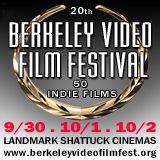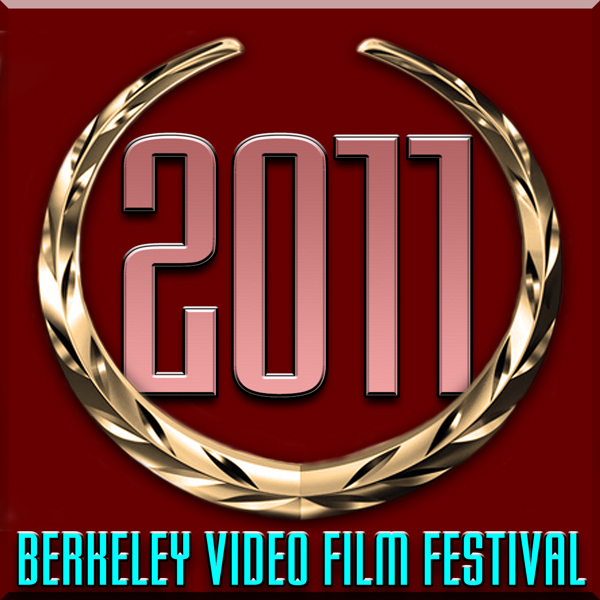BERKELEY VIDEO & FILM FESTIVAL 2011 PROGRAM
Scroll down for a Review of BVFF 2011 by Jack Foley
Friday Awards Night - BVFF Grand Festival Awards
Left to right: Kurt Hemmer-Tom Knoff -'Keenan' .... Rita Hargrave -'The Last Mambo'...Jack Foley accepts for Nic Saunders' 'At Appolinaires' Grave'... Chip Lord accepts for his 'Une Ville de l'Avenir'

Randy Rice for 'Second to None' ...Andrea Young and 'Polka Face' ...Andrew Stern's Pioneer in televison Award... The Honourable Dr. Krystoff Izdebski accepts for Sonia Bergamasco of Italia ' Esse di Salome'.

Cecil Hirvi -'Machinima' ... Elizabeth Federci - 'Space,Land and Time-Adventures with Ant Farm, Anne Keala Kelley 'Noho Hewa', Paul Kealoha Blake and Mel Vapour accept City of Berkeley Proclamation from City Councilman Jesse Arrequinn for BVFF 20 year reign.
__________________________________________
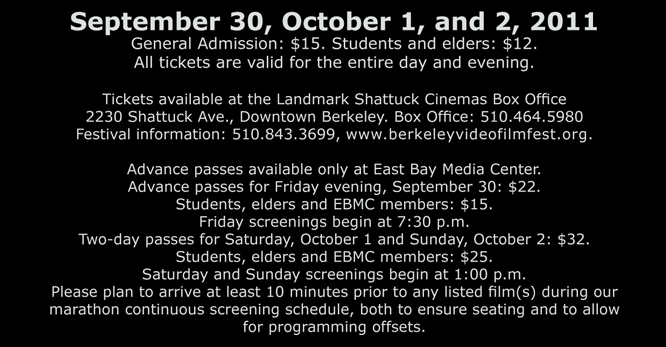
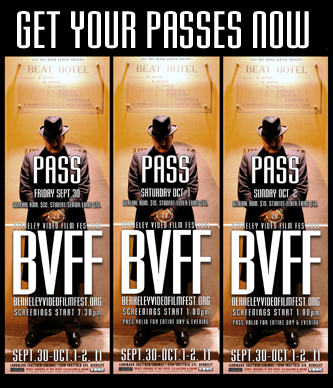
AVAILABLE AT EAST BAY MEDIA CENTER 510-843-3699
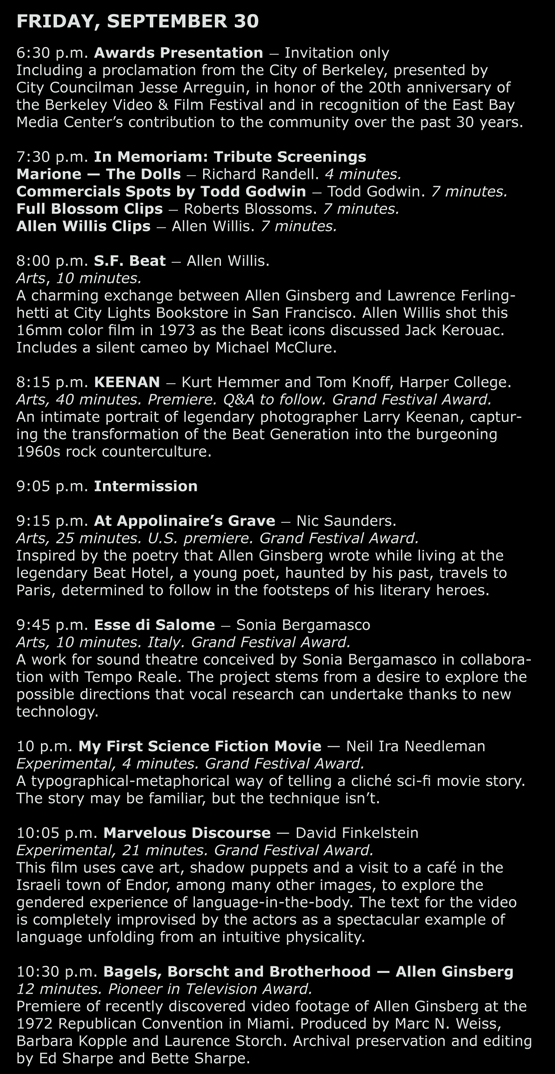
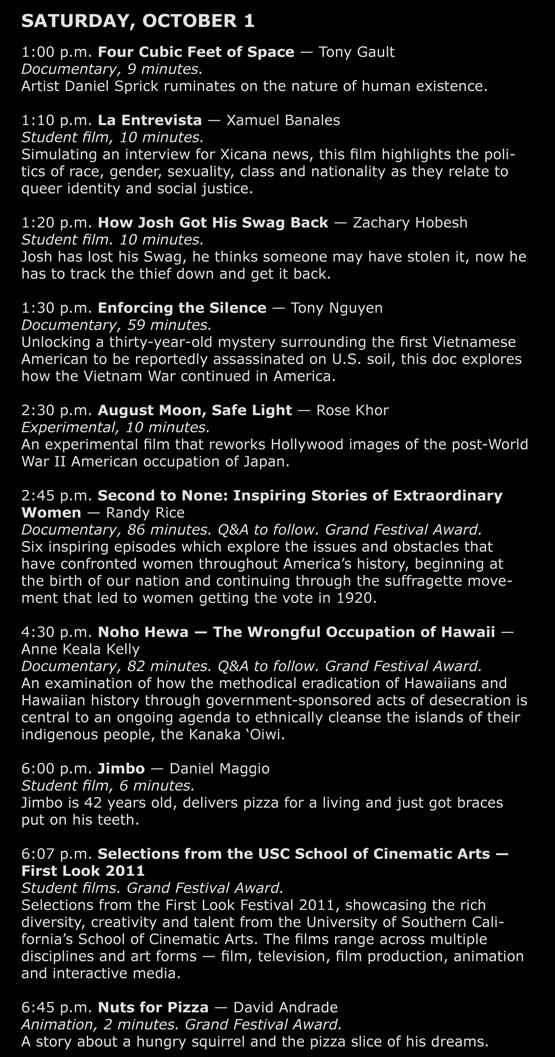
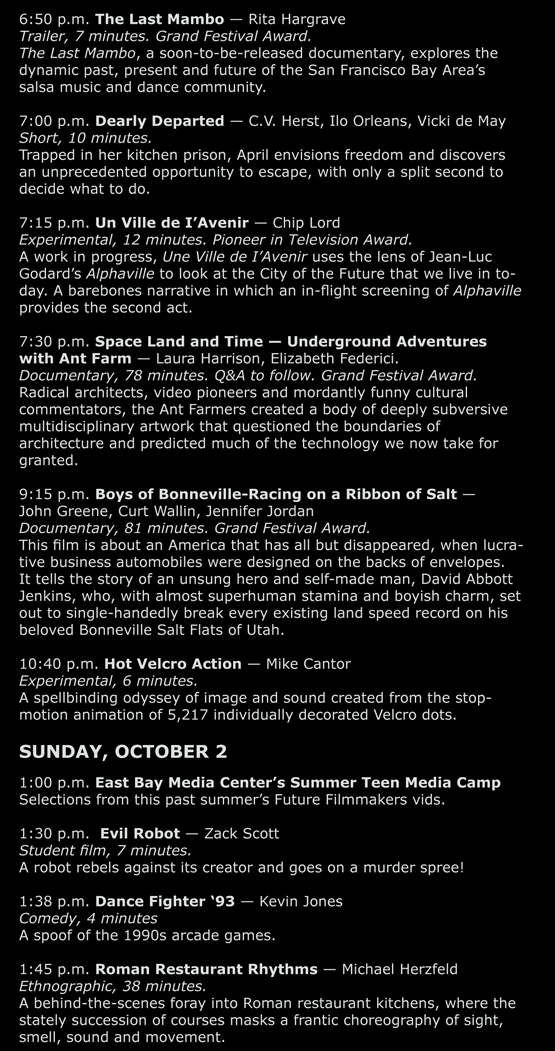
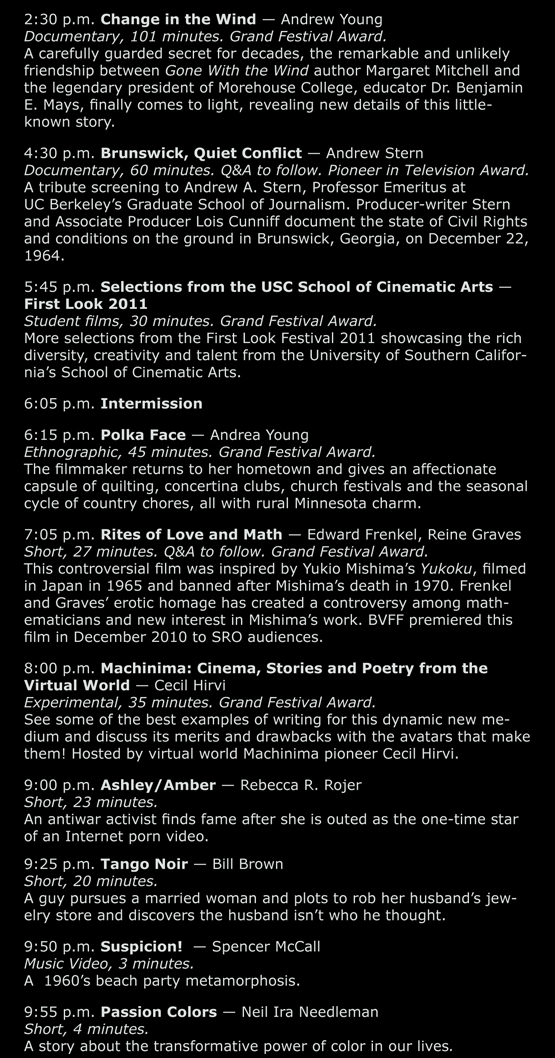
OFFICIAL SELECTIONS 2011


'AT APPOLINAIRE'S GRAVE' - BY NIC SAUNDERS - ARTS - 25:00 - U.S. Premiere - Screens Friday 9:15pm - Haunted by his past, the poet travels to Paris determined to follow in the footsteps of his literary heroes. Inspired by poetry written by Allen Ginsberg whilst living at the legendary Beat Hotel.
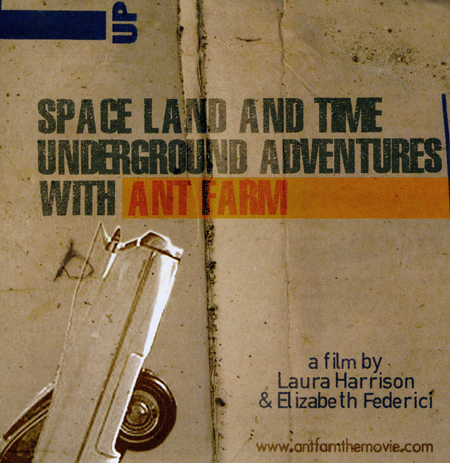

'SPACE LAND AND TIME UNDERGROUND ADVENTURES WITH ANT FARM' - LAURA HARRISON AND ELIZABETH FEDERICI - DOCUMENTARY - 77:30 - Bay Area Premiere - Q&A follows - Screens Saturday 7:30pm - Radical architects, video pioneers, and mordantly funny cultural commentators, the Ant Farmers created a body of deeply subversive multidisciplinary work that questioned the boundaries of architecture and predicted much of the technology we take for granted.
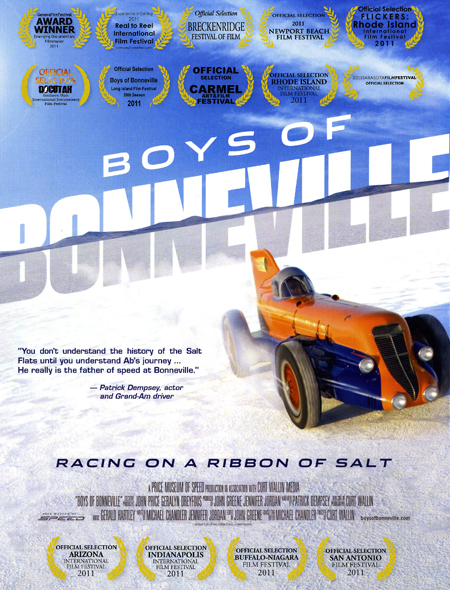
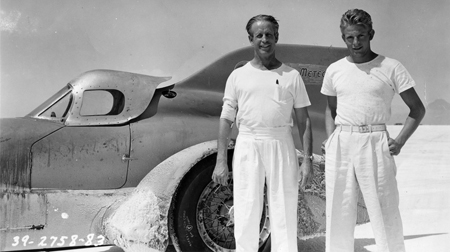
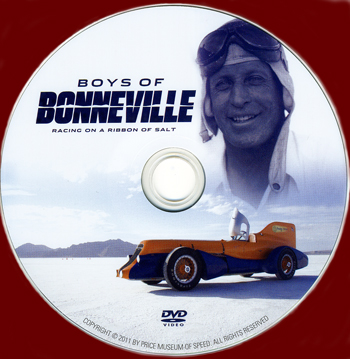

'BOYS OF BONNEVILLE: RACING ON A RIBBON OF SALT' - CURT WALLIN, JOHN GREENE, MICHAEL CHANDLER, JENNIFER JORDAN-WRITER/PRODUCER, GERALYN WHITE DREYFOUS AND JOHN PRICE EXECUTIVE PRODUCERS - DOCUMENTARY - 81:00 - Bay Area Premiere - Screens Saturday 9:15pm This film is about an America that has all but disappeared, when lucrative business automobiles were designed on the backs of envelopes. It tells the story of an unsung hero and self-made man, David Abbott Jenkins, who, with almost superhuman stamina and boyish charm, set out to single-handedly break every existing land speed record on his beloved Bonneville Salt Flats of Utah.
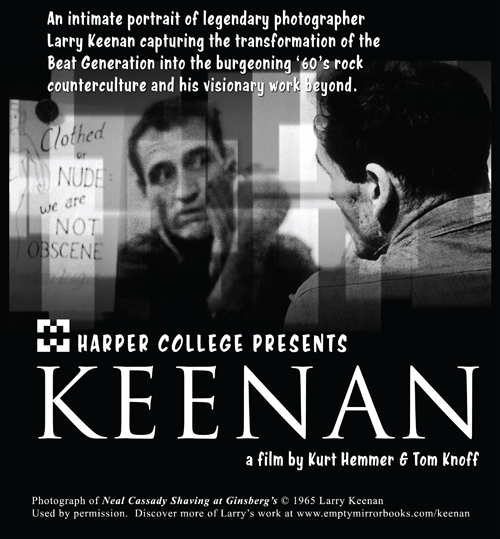

'KEENAN' - KURT HEMMER & TOM KNOFF - ARTS - Premeire - 39:32 - Q&A follows-Screens Friday 8:15pm An intimate portrait of legendary photographer Larry Keenan, capturing the transformation of the Beat Generation into the burgeoning ‘60’s rock counterculture and his visionary work beyond.
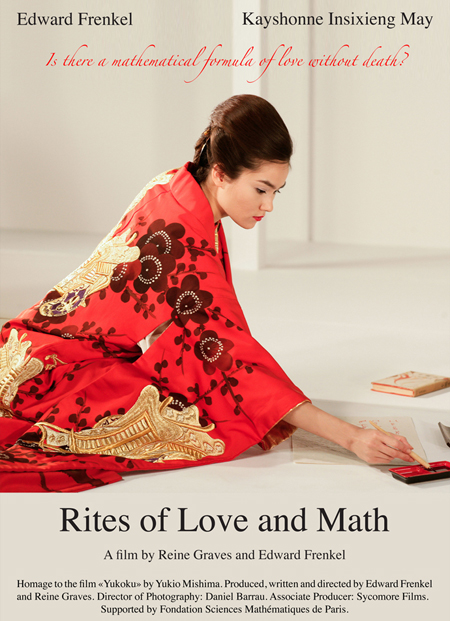

'RITES OF LOVE AND MATH' - EDWARD FRENKEL AND REINE GRAVES - ARTS -26:30 - Q&A follows - Screens Sunday 7:05pm -This controversial film was inspired by and is an homage to Yukio Mishima’s YUKOKU, originally filmed in Japan in 1965 and banned after his dramatic death in 1970. Frenkel and Graves’ erotic homage, has created a controversy amongst mathematicians and new interest in Mishima’s work. BVFF premiered the U.S. version in December 2010, to an SRO audience and had to turn away over 100 patrons. Get your tickets early for ‘Rites of Love and Math’.
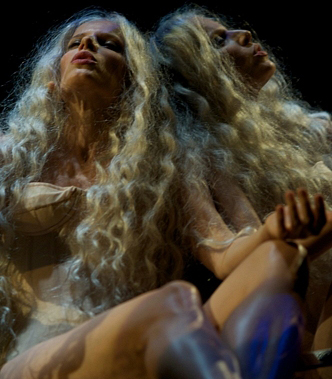

'ESSE Di SALOME' - SONIA BERGAMASCO - FRANCESCO GIOMI - ARTS - ITALIA - 10:00 - Screens Friday 9:45pm - Esse di Salome is a work for sound theatre conceived by Sonia Bergamasco in collaboration with Tempo Reale. The project stems from a desire to explore the possible directions that vocal research can undertake thanks to new technology and to find in Mallarme’s text, “Herodias,” a captivating pretext full of stimuli.
PIONEERS IN TELEVISION - TRIBUTE TO ANDREW STERN
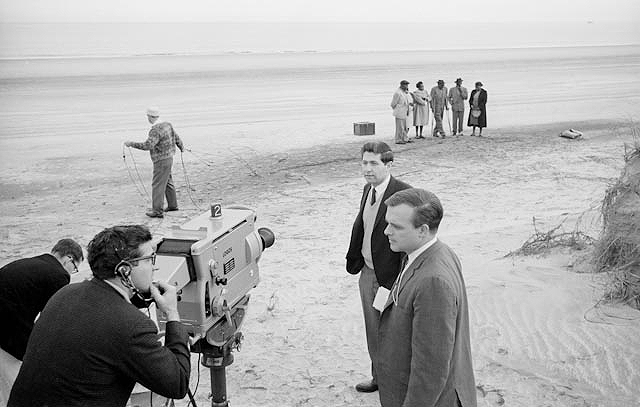
Shooting "live" opening sequence with Sea Island Singers, on Jekyll Island, Georgia
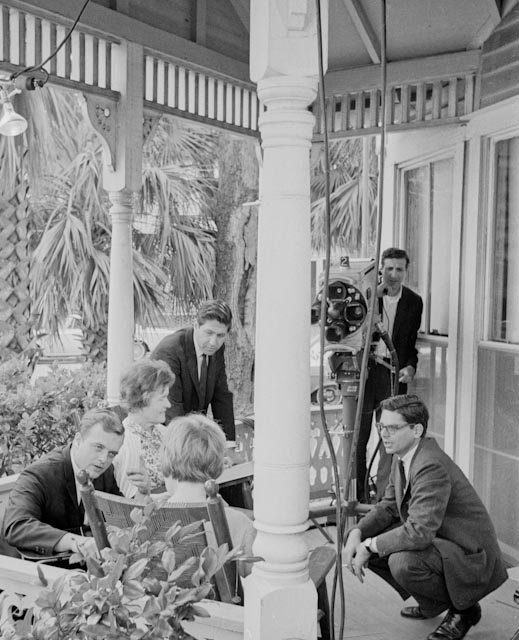

Interview set up.....Stern Lower right, note video camera and lighting.
'BRUNSWICK: QUIET CONFLICT' - ANDREW STERN - DOCUMENTARY - 60:00 - Q&A follows - Screens Sunday afternoon 4:30pm - “Brunswick: Quiet Conflict, a 1964 location video documentary examines a Southern city in Georgia, where blacks and whites were working out their differences peacefully. Producer: Andrew Stern


'NOHO HEWA: THE WRONGFUL OCCUPATION OF HAWAII' - ANNE KEALA KELLY - DOCUMENTARY - 82:00 - Q & A follows - Screens Saturday afternoon 4:30pm -This film looks at the methodical removal of Hawaiians from their homeland. It considers how the erasure of Hawaiian people and history through government sponsored acts of desecration is central to an ongoing agenda to ethnically cleanse Hawaii of the Kanaka ‘Oiwi, the indigenous population of Hawaii.
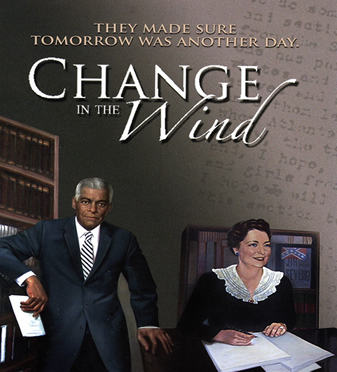

'CHANGE IN THE WIND' - ANDREW YOUNG - DOCUMENTARY -Bay Area Premiere 101:00 - Screens Sunday afternoon 2:30pm - A carefully guarded secret for decades, this remarkable, unlikely friendship between Margaret Mitchell and Dr. Benjamin E. Mays finally comes to light- as Andrew Young reveals new details about the fascinating, little known story of the 20th Century’s most influential figures.
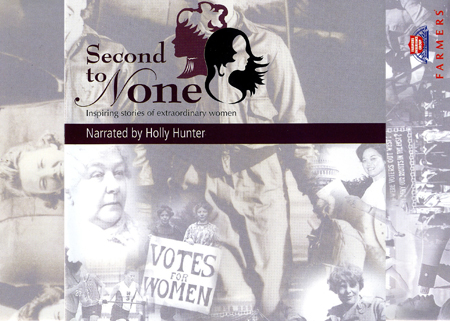

'SECOND TO NONE: INSPIRING STORIES OF EXTRAORDINARY WOMEN' – RANDY RICE – DOCUMENTARY 86:00 - Bay Area Premiere - Screens Saturday 2:30pm - Q&A TO FOLLOW - This is a series celebrating the achievements of American women. The documentary consists of six inspiring episodes which educate and promote understanding of the issues and obstacles that have confronted women throughout America’s history. Second to None begins at the birth of our nation and continues on through the suffragette movement of the 1800’s that led to women getting the vote in 1920. The documentary then takes us through the struggles that led up to the enactment of Title IX and other legislation opening new career opportunities for women in America.
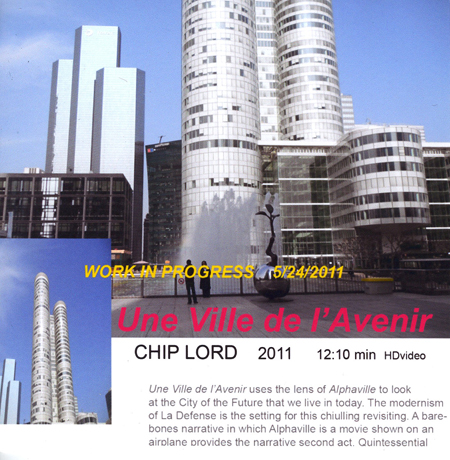

'UNE VILLE de l'AVENIR' - CHIP LORD - EXPERIMENTAL - 12:10 - Screens Saturday 7:15pm - A work in progress, Une Ville de I’Avenir uses the lens of Alphaville to look at the City of the Future that we live in today. The Modernism of La Defense is the setting for this chilling revisiting. A barebones narrative in which Alphaville is a movie shown on an airplane provides the narrative second act.
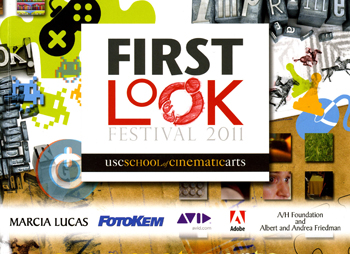

'SELECTIONS FROM USC SCHOOL OF CINEMATIC ARTS' - STUDENT FILMS - Selections from the First Look Festival 2011 bringing together the rich diversity, creativity, and talent from the USC student body across multiple disciplines and art forms in film, television, film production, animation, or interactive media.
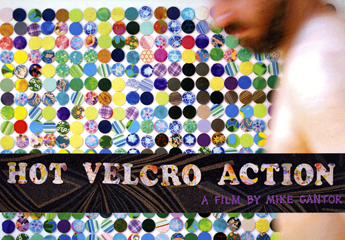
'HOT VELCRO ACTION' - MIKE CANTOR - EXPERIMENTAL - 6:05 - Screens Saturday 10:40pm - A spellbinding odyssey of image and sound created from the movement of 5217 individually decorated Velcro dots in stop-motion across a 24x17 grid.
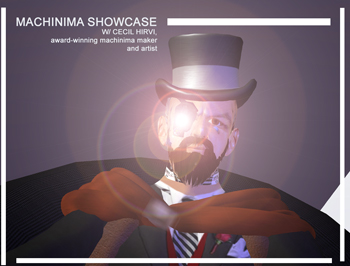

'MACHINIMA: CINEMA, STORIES, AND POETRY FROM THE VIRTUAL WORLD' WITH CECIL HIRVI - 35:00 - Sunday evening -8:00pm - Live Demonstration -
See some of the best examples of writing for this dynamic, new medium and
discuss its merits and drawbacks with the avatars that make them!
Hosted by virtual world Machinima pioneer Cecil Hirvi.
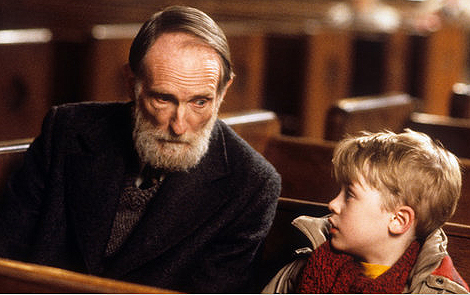
TRIBUTE TO ROBERTS BLOSSOM - Screens Friday evening - 7:30pm - Short clips from Blossoms illustrative career as an actor, poet and artist. In memoriam.
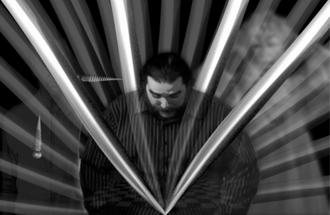

'MARVELOUS DISCOURSE' - DAVID FINKELSTEIN - EXPERIMENTAL - 21:00 -Screens Friday -10:15pm - This film uses cave art, shadow puppets, and a visit to a café in the Israeli town of Endor, among many other images, to explore the gendered experience of language-in-the-body. The text for the video is completely improvised by the actors, as a spectacular example of language unfolding from an intuitive physicality.
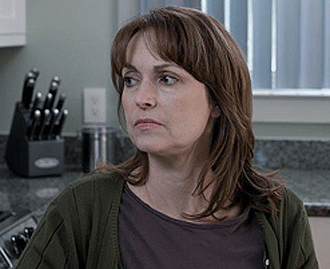
'DEARLY DEPARTED' - ILO ORLEANS - SHORT - 10:15 - Screens Saturday evening 7:00pm - Trapped in her kitchen prison, April envisions freedom and discovers an unprecedented opportunity to escape, with only a split second to decide what to do.
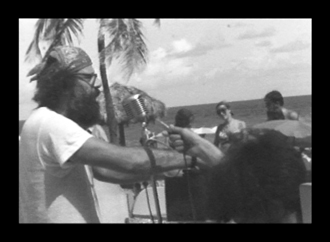

'Bagels, Borscht and Brotherhood-Allen Ginsberg' - 12:00 - Ed Sharpe, Marc N. Weiss, Barbara Kopple, Laurence Storch - 1972 Republican Convention - Miami - Premiere of recently discovered video - Screens Friday evening 10:40pm
_____________________________________________________________
BVFF 2011 Review / Editorial
VAUDEVILLE AT THE MOVIE HOUSE:
THE BERKELEY VIDEO AND FILM FESTIVAL (“BVFF”)
by Jack Foley
In 2010 Mel Vapour, co-director with Paul Blake of the city of Berkeley’s wonderful Berkeley Video and Film Festival, told Examiner reporter Jason-Louise Graham that “the BVFF blossomed out of my, and Paul Blake’s, persuasion that the 1979 Panasonic VHS camera was going to irreversibly and importantly change the course of filmmaking.” Vapour goes on in the 2011 twentieth-anniversary program, “We founded BVFF in 1991 as a venue for East Bay filmmakers and videographers and in the ensuing two decades the festival has grown into an international community, showcasing some of the world’s best cinema. Our goal has always been to present independent cinema in a mainstream venue—on the same screen where Hollywood presents its own cinematic offerings.”
The current bill at the Landmark Shattuck Cinema, 2230 Shattuck Avenue, Berkeley includes Mysteries of Lisbon, The Mill & the Cross; Circumstance; Crazy, Stupid Love; Detective Dee and the Mystery of the Phantom Flame; My Afternoons with Marguerite; Mozart’s Sister; The Black Power Mixtape 1967-1975; The Guard; The Lion King 3D—and the Berkeley Video Film Festival.
I recently saw, via Netflix, Les Plages d’ Agnès / The Beaches of Agnès, a retrospective film made by prominent Rive Gauche filmmaker Agnès Varda, niece of the once famous/notorious artist, Jean Varda—“Uncle Yanco”—whose Sausalito parties on his remodeled ferryboat became the stuff of legend.
Watching The Beaches of Agnès, I was struck by how much the film, made in 2008, reminded me of James Broughton’s Testament, made thirty-four years earlier: the presence of the beach, the ocean, the filmmaker’s attempt to assess an entire career, a life. Varda’s film was good—fine—but it tended towards the sentimental, it was a little long, a little repetitious: in short, it was nowhere nearly as good as Broughton’s little masterpiece. Yet it was certain that a lot more people would see Varda’s film than would ever see Broughton’s. In the world in which Broughton made his film, the filmmaker hopes to find, at best—in Milton’s phrase—“fit audience, though few.” To be sure, Broughton is—relatively—well known, but he isn’t as well known as Agnès Varda. And there is no publicity machine ready to take out a full page ad to tell you about his work. His are the kinds of films you have to look for.
The BVFF is a place where such films are sought out and presented with love and intelligence. Films that have left the “mainstream” behind and ventured out into the vast ocean in order to explore the boundless ecstasies of politics, chance and experimentation. Some of us remember the excitement of Ed Landberg’s Cinema/Guild Theaters in Berkeley—program notes by Pauline Kael. That was back in the 1960s. The Berkeley Video and Film Festival is what is happening now.
I attended the BVFF in order to receive as proxy the Grand Festival Award given to Nic Saunders for his wonderful new film, At Apollinaire’s Grave—about which I’ll write separately. Nic had given me some remarks to read. He said, among other things, “I was fortunate enough to attend the festival in 2009 when a film I made based on a poem by Michael McClure was screened and of all the festivals I attended with that film I found Berkeley to be the most supportive and encouraging of new filmmakers. There was never any doubt I’d submit any future film I was crazy enough to try and make and I’m honored and thrilled the festival decided to screen it and reward it so generously.” I read Nic’s remarks and accidentally substituted “twelfth festival” for “twentieth festival”: I was soon corrected about that. Mea culpa, Nic.
I enjoyed all the films I saw, though I wasn’t able to see everything. Among the highlights were these:
Some in memoriam tributes to various filmmakers including Richard Randell and Todd Godwin. Godwin’s commercials are marvels of invention, and their presentation here allowed them to make the transition from guilty pleasures to art.
The late Allen Willis’s S.F. Beat—a fascinating 1973 glimpse of Beat writers Allen Ginsberg and Lawrence Ferlinghetti discussing Ann Charters’ then recent biography of Jack Kerouac while a young, gorgeous Michael McClure looks on. Ginsberg is charismatic and compelling as he defends his late friend’s intelligence.
Keenan by Kurt Hemmer and Tom Knoff, a wonderful, joyous, illuminating portrait of the great photographer—once Michael McClure’s student—Larry Keenan. The film covers Keenan’s life and career, including the recent Parkinson’s Disease which has afflicted him but scarcely slowed him down. Because Keenan was present at so much of what has happened in this area—he took the famous Michael McClure-Bob Dylan-Allen Ginsberg photo in which McClure and Ginsberg are looking at Dylan while Dylan looks straight at the camera—the film is also a portrait of an entire era. Speaking of one particular photograph of artist Bruce Conner, McClure remarks, “It wasn’t the car, it wasn’t Bruce—it was everything that was there in that moment.” Keenan is able to find exactly the angle, exactly the moment in which whatever is happening fully announces itself: there it is, caught in an experience which, Keenan assures us, “is a physical thing with me.” Afterwards, I congratulated Keenan, who attended, on becoming a movie star.
After an intermission, At Apollinaire’s Grave. Utilizing three poems written by Allen Ginsberg when he was living at the Beat Hotel in Paris (“Át Apollinaire's Grave," "Message," "Europe! Europe!")Nic Saunders’ film lifted us into another space entirely: symbolic, richly allusive, compelling. Philip Bulcock’s performance and reading of the verse were superb—and Aden Cardy-Brown as Apollinaire’s ghost was a marvelous presence. His image graced the beautiful cover of the festival’s program.
The amazing Esse di Salome followed At Apollinaire’s Grave. A seductive woman sits, squirms, smiles, makes the most amazing sounds—mostly, I think, in Italian. Made by Sonia Bergamasco, the film is described as “a work for sound theatre. The project stems from a desire to explore the possible directions that vocal research can undertake thanks to new technology.” Indeed, it does.
That was followed by David Finkelstein’s equally amazing Marvelous Discourse. Two men, one of them the filmmaker, talk on endlessly, hilariously, while a somewhat androgynous “sorceress” moves around, dances, mugs. The often astonishing dialogue was improvised by the actors and has the effect of L=A=N=G=U=A=G=E poetry on steroids. BVFF’s program comments, “The text for the video is…a spectacular example of language unfolding from an intuitive physicality,” which seems, like the video, simultaneously puzzling and heroically accurate.
Friday evening ended with Bagels, Borscht and Brotherhood by Marc N. Weiss, Barbara Kopple and Laurence Storch—video footage of Allen Ginsberg on the beach at the time of the 1972 Republican Convention in Miami. Ginsberg couldn’t sing but does anyway, to great effect, especially when the bathing-suited audience joins in at the end. The archival preservation and editing of this film was by Ed and Bette Sharpe—with the inspiration of BVFF’s Mel Vapour, who urged Ed to select the Ginsberg footage and bring it to life for the BVFF 2011.
On Sunday I saw, first, Andrew Young’s moving Change in the Wind, a documentary about the unlikely relationship between Gone with the Wind author Margaret Mitchell (white) and Dr. Benjamin Mays, African-American president of the all-black Morehouse College in Atlanta. Mitchell died in 1949—ten years after the release of the triumphant film version of her novel. Young’s film reveals that she had privately struck a deal with Mays to anonymously underwrite scholarships to Morehouse students. The film examines how that might have come to pass—“Margaret Mitchell was a work in progress”—and provides a wonderful portrait of Dr. Mays. His poem, “Only a Minute,” is quoted:
I have only just a minute,
Only sixty seconds in it,
Didn’t seek it, didn’t choose it,
But it’s up to me to use it,
Give account if I abuse it,
Answer for it if I lose it,
Just a tiny little minute,
But eternity is in it!
In the evening I saw Edward Frenkel and Reine Graves’ Rites of Love and Math and Cecil Hirvi’s Machinima: Cinema, Stories and Poetry from the Virtual World. Rites of Love and Math combines the ambiance of a Noh play with the sound of Western opera—especially that of Wagner’s Tristan und Isolde since the film centers on a kind of liebestod, though it is only the man who dies. The death of the man—“The Mathematician”—is based on the death of the famous author Yukio Mishima, who committed ritual suicide by seppuku, and Rites of Love and Math contains several references to Yukoku (Patriotism, released in English as The Rite of Love and Death), a film Mishima wrote, directed and appeared in. Edward Frenkel, a professor of mathematics at UC Berkeley, talked about the film as an allegory in which the beautiful woman on whose body The Mathematician tattoos the mysterious “formula” of love is equivalent to Truth, long sought by the mathematician. Rites of Love and Math is complex, strange, paranoiac (there are “bad guys” who are after The Mathematician’s formula: one thinks of the academic’s need to publish first!), multiethnic, and a definite assertion that mathematicians have sex lives too! It attempts to raise cinema to the realm of the ritualistic and perhaps suggests that mathematical formulae are rituals too.
The last film I saw was an example of “machinima”: “the use of real-time 3D computer graphics rendering engines to create a cinematic production. Most often, video games are used to generate the computer animation. Machinima-based artists, sometimes called machinimists or machinimators, are often fan laborers, by virtue of their re-use of copyrighted materials” (Wikipedia). I knew nothing of this art and found Cecil Hirvi’s explanations and examples fascinating.
I was sorry to have missed Hot Velcro Action, The Last Mambo, Space Land and Time—Underground Adventures with Ant Farm, and many others. What I have described here are only a few of the wonders of the BVFF—and it will be back next year. Hosannas to the 1979 Panasonic VHS camera.
Mel Vapour insists, rightly, that his vaudeville presentations “are films that really express the important search for identity in these contemporary times of unprecedented political social and economic changes – they represent the voice of many who are silenced and also dare to criticize the authorities that would otherwise become dictatorships.” They are also, one might add, not infrequently a lot of fun.
